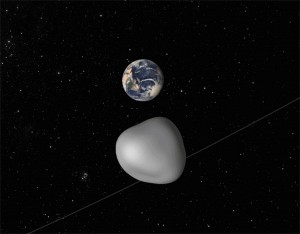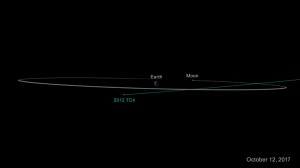TC4: Earth’s Close Shave
October 13, 2017
Yesterday, on Thursday, October 12, a house-sized asteroid buzzed Earth, passing within the orbit of the moon and uncomfortably close to hundreds of orbiting communications and weather satellites. Officials at the United States National Aeronautics and Space Administration (NASA) insisted there was never any danger of a collision. They first discovered the space rock, called 2012 TC4, five years ago and have been following it ever since. The close shave by TC4 posed no threat, but it did provide NASA with an opportunity to test systems that detect orbiting objects and to develop plans to respond to a potentially catastrophic impact.

This illustration depicts the safe flyby of asteroid 2012 TC4 as it passes by Earth on Oct. 12, 2017. Credit: NASA/JPL-Caltech
Technicians from NASA and the European Space Agency’s Near-Earth Object program measured TC4 to be about 50 to 100 feet (15 to 30 meters) in diameter. It is traveling through space at about 16,000 miles (25,800 kilometers) per hour. At its closest, it will pass by southern Australia a mere 27,300 miles (44,000 kilometers) above the surface, just beyond the 22,400-mile (36,000-kilometer) plane of Earth’s most remote geosynchronous (fixed-orbit) satellites.

This illustration shows the path of asteroid 2012 TC4 as it passes within the moon’s orbit of Earth on Oct. 12, 2017. Credit: NASA/JPL-Caltech
Technicians at the space agencies determined that TC4 makes an elongated orbit around the sun every 609 days. They calculate that TC4 will pass close to Earth again in 2050 and 2079. For now, the calculations show that there is no danger of TC4 striking Earth. However, should TC4’s orbit be deflected by even a small amount, the chances of an impact could increase. Officials say there is a 1-in-750 chance that TC4 could strike Earth sometime after 2050. Those are long odds, to be sure, but NASA scientists continue to track TC4 nonetheless, as well as 12 other asteroids with a greater risk of impact.
Scientists know that Earth has been struck by asteroids and meteors repeatedly over the past 4.5 billion years. NASA experts estimate that objects the size of TC4 fly past Earth about three times per year. They point out, however, that the chances of a serious asteroid impact anytime soon are remote. But even the experts are occasionally taken by surprise. The Chelyabinsk meteor, a chunk of rock similar in size to TC4, fell into Earth’s atmosphere and exploded over the city of Chelyabinsk in southeastern Russia on Feb. 15, 2013. The impact frightened thousands of people and took NASA and other space-observing agencies by surprise. They did not see that one coming.


